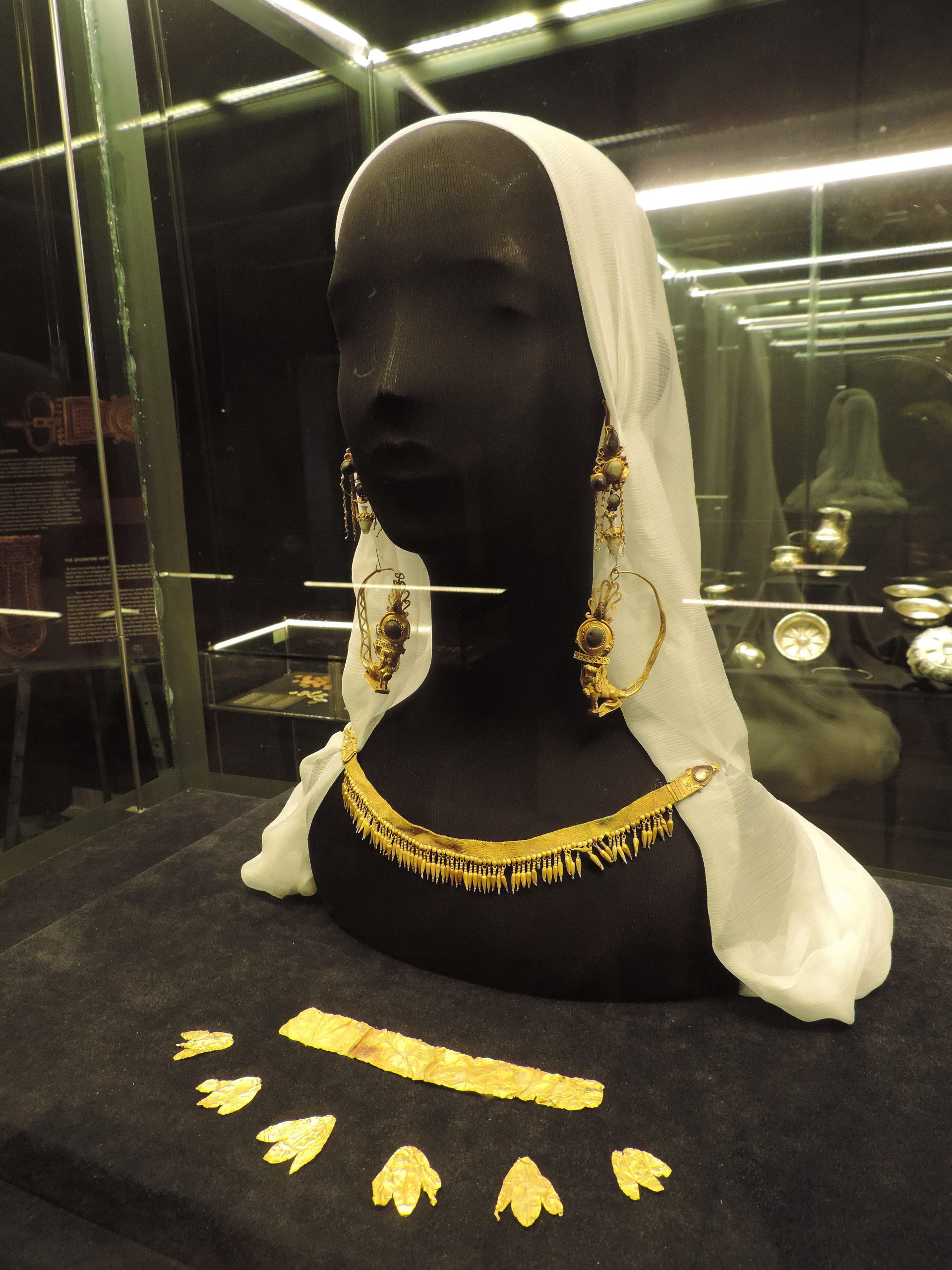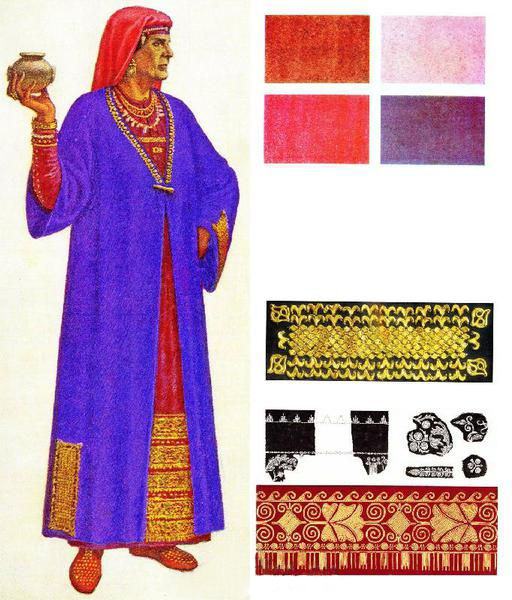A hoard of golden jewelry and a black glazed oenochoe from the Messambria [Mesembria] cemetery [ancient Greek colony in Thrace. Today Nessebar, Bulgaria], female burial, mid 3rd century BCE.
The grave finds were brought to the Ancient Nessebar Museum in the early 2009 with the cooperation of the Burgas Regional Directorate of the Ministry of Interior and the Nessebar Regional Prosecutor‘s Office.
The gold jewelry was yielded by a cist grave discovered during a house construction in the new part of the town of Nessebar (the site is within the boundaries of Messambria Cemetery Immovable Cultural Property). The cist grave was destroyed but those who had discovered it stated that it was built from precisely cut and shaped stone blocks.
The find includes many exquisite gold personal ornaments, most of them with polychrome decoration: a strap necklace, a chain necklace with a central Heracles knot, two solid intaglio rings, appliques differing in shape and size and other miniature elements of one or more tiaras as well as various types of gold beads of necklaces and long strings, which decorated the body and the attire of the buried woman. An Attic oenochoe brought to the museum together with the gold jewelry can be used to define the date of the burial – the decades after the mid-3rd century BC.
The exquisite style and the high quality of the jewelry rank them among the most famous artifacts of the Hellenistic jewelry from Northern Greece and Asia Minor. Their owner was undoubtedly a representative of the Messambria elite.
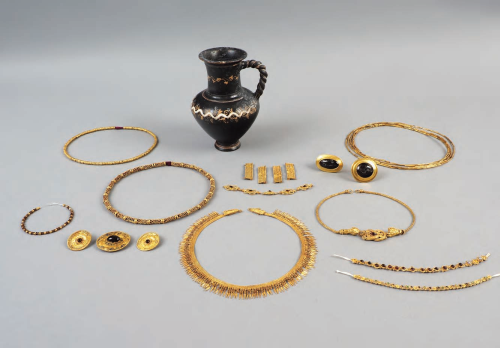

After. M. Tonkova
The most interesting are round and oval ornaments, and rectangular lamellae, originally part of a diadem most likely. Together with tiny bejeweled elements, these ornaments probably decorated a very elaborated diadem in the form of a textile headband.
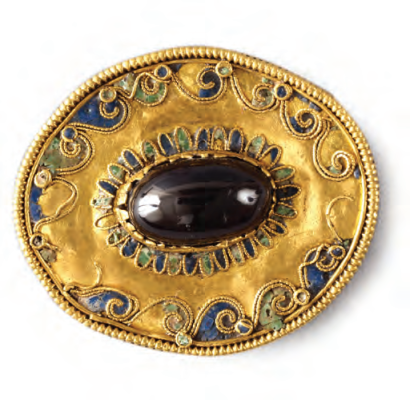
Dim. 3.2 х 2.7 cm; D socket 1.3 х 0.8 cm; D. round tubes 0.3 cm; weight 7.58 g
K. Boyadzhiev, H. Popov, K. Chukalev (eds.) 2018

1. Diam. 2.3 cm; D gemstone 0.4 cm; weight 1.72 g
2. Diam. 2.2 cm; D gemstone 0.4 cm; weight 1.61 g
K. Boyadzhiev, H. Popov, K. Chukalev (eds.) 2018
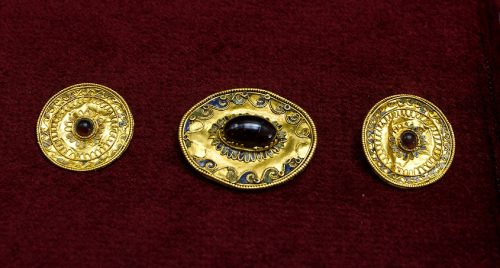
“Oval lamellae made from a gold sheet with a periphery hemmed with a beaded and plain filigree wires. There is a socket with an inlaid oval onyx-coloured cabochon in the middle. The base is decorated with ovae and the periphery is decorated with connected spirals made from filigree threads and filled in with blue and green enamel. A folded channeled band is attached at both ends on the back forming two openings for the string.
Nesebar Museum Inv. № 3879 […]
Round lamellae made from a gold sheet with a periphery hemmed with a beaded and plain filigree wires. There is a socket with an inlaid oval onyx-coloured cabochon in the middle. There are decorative bands such as a filigree rosette around the semi-precios stone socket; a band of ovae and a band of connected spirals. There are remains of blue and green enamel. A ring made from a channeled lamella for attaching is located on the back.
Nesebar Museum Inv. № 3880″ K. Boyadzhiev, H. Popov, K. Chukalev (eds.) 2018
Rectangular appliques from a diadem, 4 items
Gold, enamel; 3.5 х 0.9 cm; weight 10.77 g
“Rectangular lamellae made from a gold sheet with a periphery hemmed with a beaded and plain filigree wires. The decorative field is divided into three horizontal belts. The central one is decorated with connected triple petals forming a wreath, and the side ones – with ovae formed by a fine filigree thread. The ornaments are decorated with blue and green enamel. There are mechanisms made from folded lamellae for attaching the strips in couples at the back. There is a ring for attaching pendants at the periphery of two of them.” K. Boyadzhiev, H. Popov, K. Chukalev (eds.) 2018
Nesebar Museum Inv. № 3881
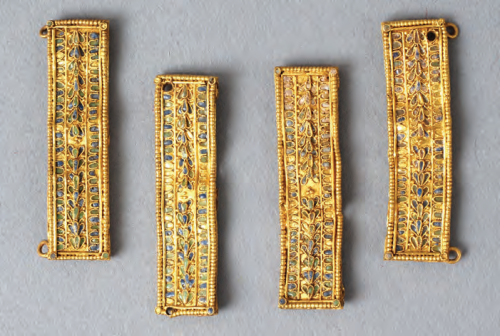
Compare to:
Necklace / diadem, gold, blue glass paste; 3rd century BCE.
Found: Panticapaeum. Crimea, the environs of Kerch
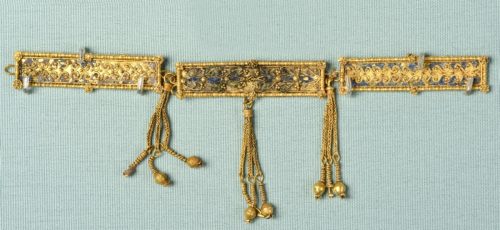
“Miniature rhomboid elements; inlaid round-shaped garnet coloured stone in the middle. They are made from beaded wire forming volutes at the two opposite ends. There is a circle made from filigree at the four corners of a rhomb and enamel traces. There is folded lamella with two openings for attaching at the back.”
Nesebar Museum Inv. № 3883
“Miniature lamellae shaped as six-petal rosettes with inlayed round garnet and green-coloured semi-precios stones. The rosette petals are decorated with a fine filigree wire and blue and green enamel.”
Nesebar Museum Inv. № 3884
Source:
K. Boyadzhiev, H. Popov, K. Chukalev (eds.) 2018

Dim. 0.8–0.6 cm; diam. gemstones 0.3 cm; weight 5.55 g
K. Boyadzhiev, H. Popov, K. Chukalev (eds.) 2018

K. Boyadzhiev, H. Popov, K. Chukalev (eds.) 2018
Cat. № 82. Elements of a tiara (?)
shaped as Heracles knot, 5 items
Gold, inlay
Large: 2.1 х 0.9 cm; small: 1.7 х 0.7 cm;
3rd century BC
The elements represent a lacework Heracles knot with inlaid gem stones in the center. The Heracles knot is made from
a reel-shaped wire with cuts, made by a mold. There are rings for attaching at the ends. Four of the elements are identical in size and bigger than the fifth one. There are rhomboid sockets in the center of each one with an inlaid semi-precious dark red stone (garnet?). The smaller fifth element has a socket in the middle. It is round with an inlaid semi-precious hemispherical stone of the same color.
Inv. № 3882

NECKLACES
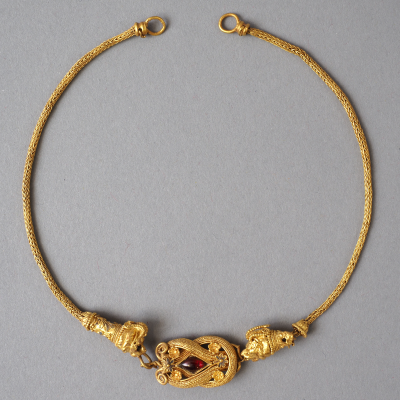
Chain necklace with a central Heracles knot
First half of the 3rd century BCE
Gold, inlay, enamel.
L 29.5 cm; L Heracles knot 2.3 x 1.4 cm; weight 18.16 g
“The jewel consists of three pieces: two chains connected to a central Heracles knot. The chains have round cross-section and there are small rings at the free ends. clasps shaped as lion-griffin heads can be found at other end. They are connected with a Heracles knot consisting of band-shaped lamellae covered with five rows of twisted and braided filigree wires. There is diamond-shaped socket inlaid with a reddish cabochon (garnet?) in the middle. The floral ornaments on the clasps and the Heracles knot are decorated with filigree enamel. The jewel could be used as a tiara, as a chain necklace or as a hip decoration.” N. M. Inv. № 3878
Late 4th – early 3rd century BCE
“The strap necklace consists of four interlinked loop in loop chains. Three-lobed beech nut pendants are attached to the lower part by three connected small rings. Small rosettes are attached to the links. The clasps are made of triangular lamellae decorated with palmette and ornaments of different types of filigree wires. A ring and a hook for attaching are located at the ends.”
Inv. № 3876


dim. of a bead: L 0.2 cm; D 0.2 cm
Ca. mid-3rd century BC
Tiny beads shaped as reel-shaped tubes.
Inv. № 3888

L 0.4 cm; D 0.3 cm; weight 18.27 g 3rd century BC
The beads are cylindrical, transverse grooved. They are made from a folded lamella with marked edges.
Inv. № 3887

Gold
L varying from 0.5 to 1.2 cm 3rd century BC
The beads are cylindrical, made from thin gold sheet.
Inv. № 3889
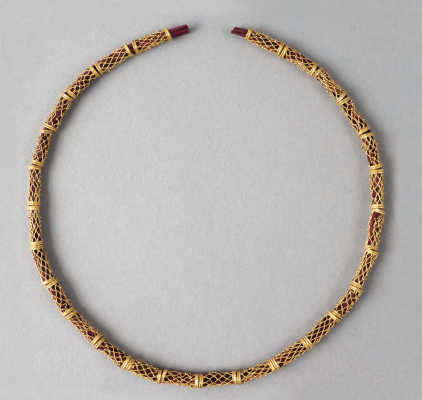
Gold
L beads 1.3 cm; Diam. 0.4 cm; total weight 15.33 g
Ca. mid-3rd century BC
A necklace of small lacework cylindrical beads made from a net of even threads, zig-zag connected with beads fixed at the links.
Inv. № 3886
RINGS
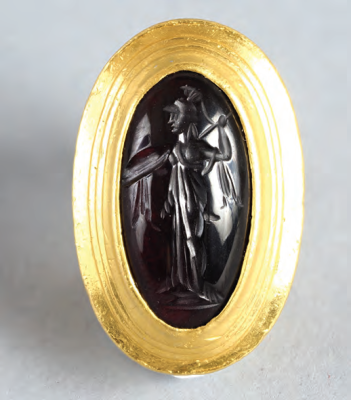
D ring 2 х 1.7 cm; T ring 0.7 cm; lamella 3.5 х 2.3 cm; gem stone 2.4 х 1.3 cm; weight with the gem stone 28. 85 g
Ca. mid-3rd century BC
The ring has expanding shoulders and ellipsoid socket profiled in four levels. The ring is band-shaped following the form of the finger. The intaglio is onyx-coloured with a carved image of Athena Alkidemos, standing to the left, fully accoutered.
N. M. Inv. № 3877


Gold, intaglio
D ring 2.4 х 1.8 cm; T ring 0.8 cm; D socket 3.2 х 3 cm; D gem stone 1.9 х 1.7 cm; weight including the gem stone 40.16 g
Ca. mid-3rd century BCE
The ring has expanding shoulders and almost round socket profiled in two levels. The ring is band-shaped following the form of the finger. The intaglio is onyx-colored with a carved image of a seated semi-naked woman (probably Aphrodite) to the right with a „melon“ hairstyle.
N. M. Inv. № 3890
Black glazed oenochoe. Clay
H 12.6 cm; D rim 6 cm; D base 3.5 cm
Ca. mid-3rd century BCE
The vessel is made of fine, light red clay covered with black glaze. It has high cylindrical neck, biconical body and low ring base. The handle is twisted. There is red and white “West Slope” decoration on the neck and the belly. Attic workshop. N. M. Inv. № 3891

SOURCES:
- K. Boyadzhiev, H. Popov, K. Chukalev (eds.) 2018. Saved treasures of Bulgaria. Exhibition catalog. Sofia: NAIM-BAN, ISSN 2367-8860, ISBN 978-954-9472-65-3. 184 pages
[К. Бояджиев, Х. Попов, К. Чукалев (ред.) 2018. Спасени съкровища на България. Каталог към изложба. София: НАИМ-БАН, ISSN 2367-8860, ISBN 978-954-9472-65-3. 184 стр.] - https://bnr.bg/hristobotev/post/101051738
- The jewellery of a wealthy Thracian woman from Anchialos and the fashion in Middle and Late Hellenistic jewellery by Milena Dimitrova Tonkova






